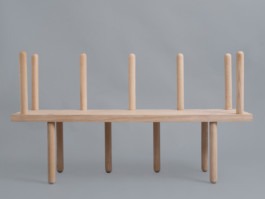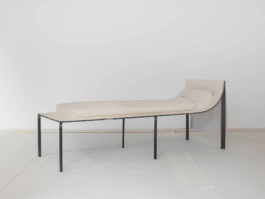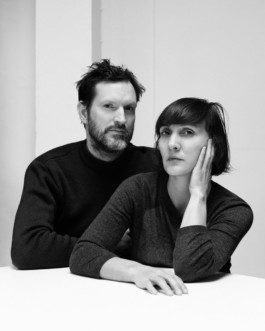



MANIERA, MOS, Peg Bench.2021. Image © MOS.
Design bites
MANIERA
24 May 2021
This new series, Design bites, unveil the backstage of contemporary creation. Tackling various topics from personal designer processes to the position of Collectible design on the global design market; these bites offer different views to suit all tastes. Today we talk with Kwinten Lavigne and Amaryllis Jacobs from MANIERA.
COLLECTIBLE: How did you get into collectible design? Why did you start your gallery?
Kwinten Lavigne and Amaryllis Jacobs: Kwinten and me both come from the art world. We worked in big art institutions, WIELS and BOZAR respectively. He is specialised in (art) production, me in programming and communication. The idea for MANIERA has its roots in these moments when we were searching for a good format to work together, to do something with our shared attraction to art, architecture and objects and a great desire to make and show things. While developing the concept of the gallery, we came to the conclusion that most of the relevant historic design objects were made by architects. No need to give examples. On the other hand, we (and Kwinten long before me) were very interested in the work of artists who play with the connections between art, architecture and design. Many significant artists created functional objects. Think Donald Judd or Franz West. An ever-greater number of artists today, refer to architecture and design in their work or use them as media. The concept of MANIERA is very simple. We invite architects who have a close relationship to the visual arts and artists who are clearly inspired by architecture or design to develop furniture. Since most of the time they never did it before we guide them in the design process, help produce the pieces, exhibit and sell them in – mostly – limited editions.
“While developing the concept of the gallery, we came to the conclusion that most of the relevant historic design objects were made by architects. No need to give examples.”
C: Can you talk about the designers you present for COLLECTIBLE SALON, what makes their practice/pieces unique?
KL & AJ: NY based architecture firm MOS mixes vernacular aesthetics with digital design and playfulness. They continue on the tradition of American architects such as Venturi and Scott Brown. They work on a variety of projects. They design big and small buildings, they develop software for parametric design, and they make books and objects. Everything is made with the dedication of a craftsman. And they teach at Princeton. For MANIERA, they designed outdoor furniture inspired by Shaker designs. The Shakers were nineteenth-century America’s largest and most well-known communal utopian society, boasting thousands of Brothers and Sisters in the early 1800s. Today only a handful remain, and yet their legacy is long. Their work ethic, high-quality output, and objects made to last are concerns that continue to have currency today.
We will show the pieces in the garden of the Roelants House, designed by Willy Van Der Meeren (another architect who made great furniture). The house itself will be furnished with other recent pieces from our collection. Mainly pieces by Francesca Torzo and Lukas Gschwandtner.
C: How do you discover new designers?
KL & AJ: We invite architects and artists with a very specific maniera*, who have developed a idiosyncratic and very recognisable formal language. Some examples: the radical avant-garde OFFICE Kersten Geers David VanSeveren, the minimal and conceptual Jonathan Muecke, Studio Mumbai’s unique relationship with culture, nature and crafts, the historically inspired and materials driven – highly sensual – work of Italian Francesca Torzo vs. the rigorous and analytical Bernard Dubois or the crazy stories and colours of Christoph Hefti.
* Maniera is an Italian term, an invention of Giorgio Vasari, architect and art historian, who wrote that after the High Renaissance, for the first time artists developed their own maniera, method and formal language. Previously, they followed the trend of the times. Today, artists and architects are only as interesting as their own specific manner, their own unique and consistent way of thinking and doing.
C: What is the relation you hold with the designers you work with?
KL & AJ: They all just became very good friends.

MANIERA, MOS Architects. Image © MOS.

MANIERA, Lukas Gschwandtner, Chaise Longue, 2021. Image © Lukas Gschwandtner.
About MANIERA (Belgium)
MANIERA gallery commissions architects and artists to develop furniture and objects for use, offering them an excursion beyond their usual practice. As architects often have a close relationship with the visual arts, and artists are frequently inspired by the spatial environment, MANIERA intends to crystalise these proximities into new design proposals. More than just furniture, the objects created by MANIERA are a deliberate search for collisions between the realms of architecture, design, and art.

Kwinten Lavigne and Amaryllis Jacobs portrait © Jef Jacobs.
Design bites
MANIERA
24 May 2021

MANIERA, MOS, Peg Bench.2021. Image © MOS.
This new series, Design bites, unveil the backstage of contemporary creation. Tackling various topics from personal designer processes to the position of Collectible design on the global design market; these bites offer different views to suit all tastes. Today we talk with Kwinten Lavigne and Amaryllis Jacobs from MANIERA.
COLLECTIBLE: How did you get into collectible design? Why did you start your gallery?
Kwinten Lavigne and Amaryllis Jacobs: Kwinten and me both come from the art world. We worked in big art institutions, WIELS and BOZAR respectively. He is specialised in (art) production, me in programming and communication. The idea for MANIERA has its roots in these moments when we were searching for a good format to work together, to do something with our shared attraction to art, architecture and objects and a great desire to make and show things. While developing the concept of the gallery, we came to the conclusion that most of the relevant historic design objects were made by architects. No need to give examples. On the other hand, we (and Kwinten long before me) were very interested in the work of artists who play with the connections between art, architecture and design. Many significant artists created functional objects. Think Donald Judd or Franz West. An ever-greater number of artists today, refer to architecture and design in their work or use them as media. The concept of MANIERA is very simple. We invite architects who have a close relationship to the visual arts and artists who are clearly inspired by architecture or design to develop furniture. Since most of the time they never did it before we guide them in the design process, help produce the pieces, exhibit and sell them in – mostly – limited editions.
“While developing the concept of the gallery, we came to the conclusion that most of the relevant historic design objects were made by architects. No need to give examples.”
C: Can you talk about the designers you present for COLLECTIBLE SALON, what makes their practice/pieces unique?
KL & AJ: NY based architecture firm MOS mixes vernacular aesthetics with digital design and playfulness. They continue on the tradition of American architects such as Venturi and Scott Brown. They work on a variety of projects. They design big and small buildings, they develop software for parametric design, and they make books and objects. Everything is made with the dedication of a craftsman. And they teach at Princeton. For MANIERA, they designed outdoor furniture inspired by Shaker designs. The Shakers were nineteenth-century America’s largest and most well-known communal utopian society, boasting thousands of Brothers and Sisters in the early 1800s. Today only a handful remain, and yet their legacy is long. Their work ethic, high-quality output, and objects made to last are concerns that continue to have currency today.
We will show the pieces in the garden of the Roelants House, designed by Willy Van Der Meeren (another architect who made great furniture). The house itself will be furnished with other recent pieces from our collection. Mainly pieces by Francesca Torzo and Lukas Gschwandtner.
C: How do you discover new designers?
KL & AJ: We invite architects and artists with a very specific maniera*, who have developed a idiosyncratic and very recognisable formal language. Some examples: the radical avant-garde OFFICE Kersten Geers David VanSeveren, the minimal and conceptual Jonathan Muecke, Studio Mumbai’s unique relationship with culture, nature and crafts, the historically inspired and materials driven – highly sensual – work of Italian Francesca Torzo vs. the rigorous and analytical Bernard Dubois or the crazy stories and colours of Christoph Hefti.
* Maniera is an Italian term, an invention of Giorgio Vasari, architect and art historian, who wrote that after the High Renaissance, for the first time artists developed their own maniera, method and formal language. Previously, they followed the trend of the times. Today, artists and architects are only as interesting as their own specific manner, their own unique and consistent way of thinking and doing.
C: What is the relation you hold with the designers you work with?
KL & AJ: They all just became very good friends.

MANIERA, MOS Architects. Image © MOS.

MANIERA, Lukas Gschwandtner, Chaise Longue, 2021. Image © Lukas Gschwandtner.
About MANIERA (Belgium)
MANIERA gallery commissions architects and artists to develop furniture and objects for use, offering them an excursion beyond their usual practice. As architects often have a close relationship with the visual arts, and artists are frequently inspired by the spatial environment, MANIERA intends to crystalise these proximities into new design proposals. More than just furniture, the objects created by MANIERA are a deliberate search for collisions between the realms of architecture, design, and art.

Kwinten Lavigne and Amaryllis Jacobs portrait © Jef Jacobs.
Contact
info@collectible.design
VIP PORTAL
EXHIBITOR PORTAL
PRIVACY POLICY
© 2025 Collectible
Contact
info@collectible.design
VIP PORTAL
EXHIBITOR PORTAL
PRIVACY POLICY
© 2025 Collectible